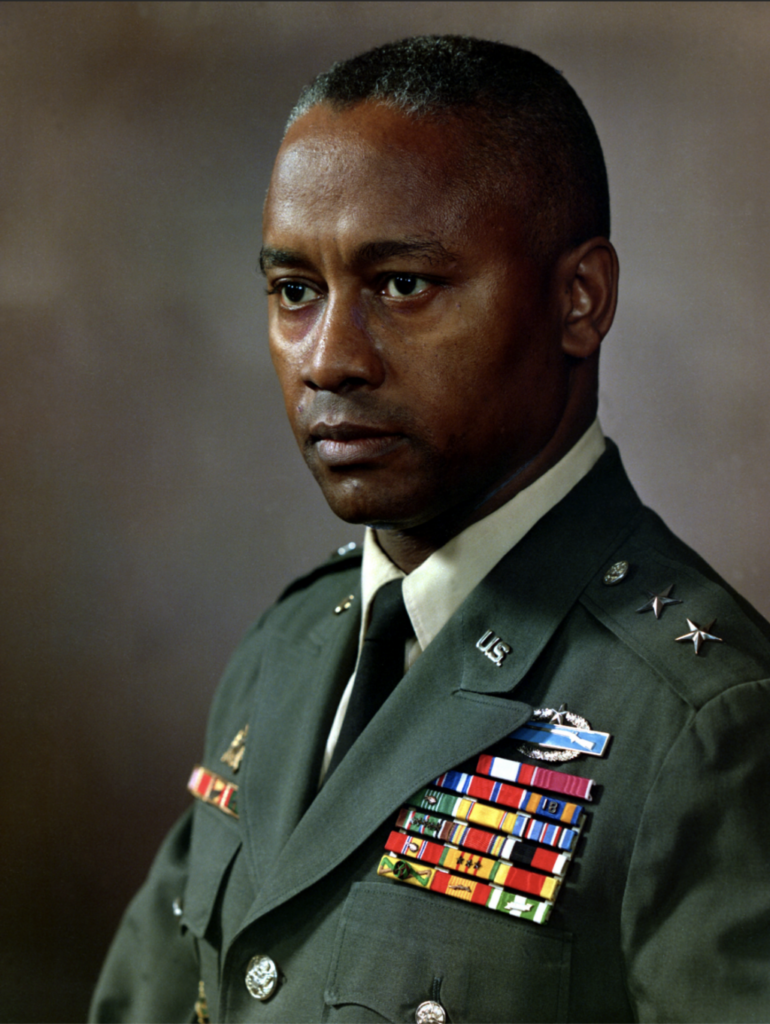Major General Frederic Davison blazed his own trail in the United States Armed Forces, eventually becoming the first Black person to reach the Army’s highest peacetime rank and to command an Army division.
According to The Dig, Davison began his rise through the military ranks at Howard University when he was made an Army Second Lieutenant through his participation in Howard’s ROTC program.
After graduating in 1938, Davison received a graduate degree in zoology in 1940, just before being called to active duty in 1941 during World War II.
At first, Davison served as platoon leader of the all-Black 92nd Infantry Division, the Buffalo Soldiers, that division was the only Black military division to see combat during the war.
Eventually, Davison became a commander of the 336th and 371st regiments; in the 336th, Davison served with Edward Brooke, a fellow Howard alum who would eventually serve as the first Black person elected to the United States Senate.
Following the war, Davison was given the duty of commanding the 365th Infantry Regiment and also served in West Germany as an executive officer of the 370th Armoured Infantry Division.
He also became one of the first Black people to graduate from the Army War College, which is responsible for training senior military and civilian leaders in global national security protocols.
Davison also served during the unpopular Vietnam War as a commander of the 199th Light Infantry Brigade, which was responsible for defending the United States II Field Force in Long Binh, Vietnam which remains one of the largest Army command headquarters in United States military history.
The 199th’s bravery in combat missions earned them a Valorous Unit Award for extraordinary heroism and a Vietnamese Cross of Gallantry from the South Vietnamese government.
After receiving those honors, in 1968, Davison was promoted to Brigadier General, following in the footsteps of Benjamin O. Davis Sr. and Jr., and he became the third Black person to achieve that rank.
He also became the first Black person to command white soldiers in combat. After his promotion, when asked about America’s racial progress on ABC News, Davison gave a somewhat hopeful answer.
“We have, I believe, the finest society that has come into being in the history of man,” Davison said. “However, we have human beings that are operating that society. They’re good, they’re bad, they’re indifferent. Consequently, in various situations, there are occasions, many occasions, where people are discriminated against and where there are not equal opportunities. However, bear in mind that any society must eventually evolve from poor to good to the finest. I think we have reached a pretty high state in the United States.”
Davison continued, “I believe that opportunity is there. It’s not entirely equal as yet. It is equalizing as we go along. Until such time as it is completely equalized, it means that the individual Negro might have to do more than his fair share to get the
acknowledgment he needs and the acknowledgment that he deserves. On the other hand, I think he must meet this challenge, and it is, in fact, a challenge that must be met if he is to succeed. My only word is, if the individual digs in hard enough, demonstrates sufficiently high enough his potential and his capability, he can’t be denied.”Later, in 1971, Davison was promoted to major general, becoming the first Black person to achieve this rank, the highest peacetime permanent rank in the United States Army.
This rank carried a two-star designation, and Davison also received command of the 8th Infantry Division, which made him the first Black division commander.
Later, Davison would become the commander of the Washington Military District, a division responsible for planning the defense of Washington, D.C.; additionally, that division is responsible for all of the ceremonial duties at Arlington National Cemetery and others in the nation’s capital.
After Davison retired from the Army in 1974, he returned to his alma mater, where he served as an executive assistant to Howard’s president, James Cheek, until 1985.
Davison also promoted housing assistance in Washington, D.C., after his military career concluded. The General Frederic Davison House, a homeless shelter and recovery house, is named in his honor.
Davison died on Jan. 24, 1999, after battling a kidney ailment at the age of 82. He is buried at Arlington National Cemetery.
RELATED CONTENT: Monica R. Lawson Makes History as First Black Woman to Rise From Chaplain to Colonel in the U.S. Army


